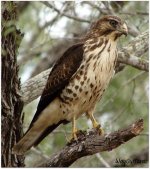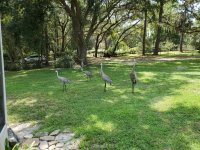G
Guest
Guest
NO-t/SC - (Not Off-topic, See Conclusion)
Also not at Hawk Mountain during fall migration, although I highly recommend a visit.
There are occasionally soaring kettles of hawks there, all condensed, riding a thermal south between the narrowing ridgeline vee. Even when it is just a few here and there the pro-birders are simply amazing to listen to*; able to identify immature, species, gender with the naked eye before I can find them with binoculars. If you are close enough Hawk Mountain is worth a visit during fall migration.
https://www.hawkmountain.org/
This was not Hawk Mountain; this was twenty minutes of staring patiently out a house window. And worth it.
The Sharp Shinned hawk that feasts on wrens and sparrows near the birdfeeders landed atop a fence post at the edge of the pasture and remained there, motionless during a heavy snowfall. Motionless for a solid 20 minutes, starting to look like a snowy mound.
I can tell when he (she) is around; our feeders are often mobbed, during a snow there are 3x the number of birds as there are perches, and a lot of squabbling. And then, suddenly, poof, like magic, not a bird to be seen. It’s hawk watch time.
I’ve watched her (him?) grab one in mid-air, take it to the ground and then fly through the (closely spaced) 6-line electric fence while awkwardly carrying lunch, to land in the pasture and tear it apart. Nature, red in tooth and claw. A hawk’s gotta eat too.
This time it (they/them) sat there, sat there, sat there motionless until the feeders were once again mobbed, and then waited some more, until an unfortunate incautious meal few too close. Lightning fast, and lunch was served. I hope it was one of the dang house wrens that prefers to nest in my canoe stems, or in my shop if I open the garage doors.
*OK, you know me, and stories, can’t resist.
About the Hawk Mountain pro-birder identification dialog, an Ornithologist friend was there when the pro birders were vying for first to call out identifications. He waited for his chance and went off on a sudden riff, sounding reasonably normal at first. I wish I had the specifics of his trickster call, something like:
Pointing vaguely out to the north, beginning with a standard ID call “Northern Goshawk” or somesuch.
But becoming increasingly detailed as he raised his binoculars, “Adult female”. . . . . pause. . . . .“You can clearly see the white eyebrow”. . . . . “And look, even the red eye”. . . .
And more incredibly more fantastically detailed; “She’s banded”. . . . .pause. . . . . “Out of southern Ontario. . . . . “Hatched on the north shore of Georgian Bay”. . . .pause . . . . . “From a nest in a lightning-struck maple”. . . . .
It was a thing of perfectly timed performance art, intoned authoritatively deadpan while staring intently into the distance. Most of the birders took it well, saw the humor and were able to laugh at their own antics.
That was, undoubtedly, his point.
I will bring this back around to canoeing. A quietly paddled canoe, in marsh or swamp, lake edge or slow river is, in my estimation, the best way to see birdlife and other critters.
Beats walking.
Also not at Hawk Mountain during fall migration, although I highly recommend a visit.
There are occasionally soaring kettles of hawks there, all condensed, riding a thermal south between the narrowing ridgeline vee. Even when it is just a few here and there the pro-birders are simply amazing to listen to*; able to identify immature, species, gender with the naked eye before I can find them with binoculars. If you are close enough Hawk Mountain is worth a visit during fall migration.
https://www.hawkmountain.org/
This was not Hawk Mountain; this was twenty minutes of staring patiently out a house window. And worth it.
The Sharp Shinned hawk that feasts on wrens and sparrows near the birdfeeders landed atop a fence post at the edge of the pasture and remained there, motionless during a heavy snowfall. Motionless for a solid 20 minutes, starting to look like a snowy mound.
I can tell when he (she) is around; our feeders are often mobbed, during a snow there are 3x the number of birds as there are perches, and a lot of squabbling. And then, suddenly, poof, like magic, not a bird to be seen. It’s hawk watch time.
I’ve watched her (him?) grab one in mid-air, take it to the ground and then fly through the (closely spaced) 6-line electric fence while awkwardly carrying lunch, to land in the pasture and tear it apart. Nature, red in tooth and claw. A hawk’s gotta eat too.
This time it (they/them) sat there, sat there, sat there motionless until the feeders were once again mobbed, and then waited some more, until an unfortunate incautious meal few too close. Lightning fast, and lunch was served. I hope it was one of the dang house wrens that prefers to nest in my canoe stems, or in my shop if I open the garage doors.
*OK, you know me, and stories, can’t resist.
About the Hawk Mountain pro-birder identification dialog, an Ornithologist friend was there when the pro birders were vying for first to call out identifications. He waited for his chance and went off on a sudden riff, sounding reasonably normal at first. I wish I had the specifics of his trickster call, something like:
Pointing vaguely out to the north, beginning with a standard ID call “Northern Goshawk” or somesuch.
But becoming increasingly detailed as he raised his binoculars, “Adult female”. . . . . pause. . . . .“You can clearly see the white eyebrow”. . . . . “And look, even the red eye”. . . .
And more incredibly more fantastically detailed; “She’s banded”. . . . .pause. . . . . “Out of southern Ontario. . . . . “Hatched on the north shore of Georgian Bay”. . . .pause . . . . . “From a nest in a lightning-struck maple”. . . . .
It was a thing of perfectly timed performance art, intoned authoritatively deadpan while staring intently into the distance. Most of the birders took it well, saw the humor and were able to laugh at their own antics.
That was, undoubtedly, his point.
I will bring this back around to canoeing. A quietly paddled canoe, in marsh or swamp, lake edge or slow river is, in my estimation, the best way to see birdlife and other critters.
Beats walking.





